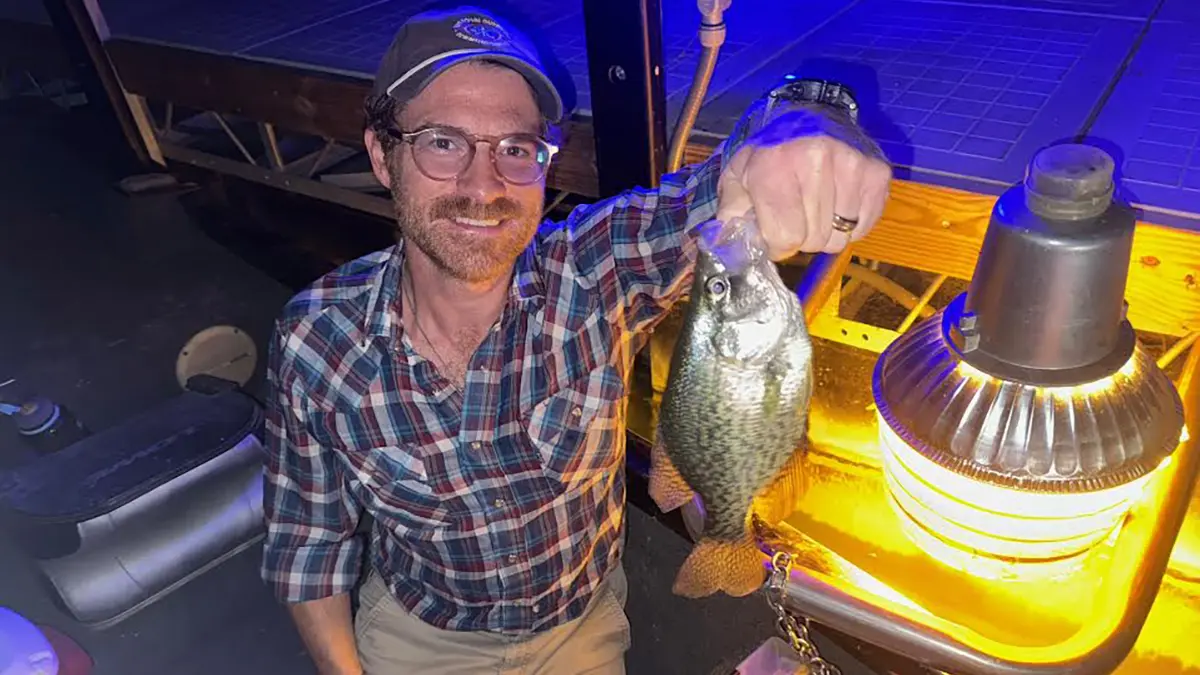The difference in fishing was as clear as night and day. Literally. On a hot summer day, the fish were sluggish and unwilling to bite. But when the sun set and night fell, there was a noticeable change. Kyle Stewart and I sat in my boat parked under a light shining into the water at the end of a dock, and watched a food chain develop.
First, the plankton began to cloud the water directly under the light’s beam. Then the minnows began to dart around. And it wasn’t long before a school of small shad circled the light. In the fuzzy layer below that forage, Stewart and I could make out gamefish lurking, attracted to the nightly smorgasbord of food.
HOT ACTION UNDER THE LIGHTS
When I lowered a small minnow into the water at the edge of the beam, I immediately felt a tap and then a sustained pull. Seconds later, I had a 12-inch crappie in the boat. Not long after, Stewart had a fish of his own, a cookie cutter of the one I caught. That was the start of a frenzied period of fishing. My locator indicated a layer of water down to 20 feet from the surface that was full of activity. And it didn’t lie.
Interestingly, the fuzzy layer below that depth apparently showed the thermocline, a layer where the warmer, oxygen-rich water of the top layer met the colder water in the bottom layer. Below that narrow band, the water was devoid of oxygen…and devoid of fish activity. So, we knew to drop our baits no more than 20 feet down in 40 feet of water. We guessed at getting our baits in the right zone by letting out a few stretches of line equal to the lengths of our light-action spinning rods. Whatever the case, it worked. We enjoyed steady action on big crappies that we measured on a bump board until the bite finally slowed and we were able to relax and watch the show.
A couple of giant carp glided under the light and then disappeared in the darkened water under the docks. And several large crappies floated up so listlessly that we thought they were fish we had released and were still recovering, only to see them suddenly come to life and grab a small minnow, then descend again.
Welcome to the summertime nightlife. From the heat of summer into early fall, it’s one of my favorite activities.
ENJOYING THE NIGHT LIFE
I started by buying several floating lights housed in styrofoam and hooking them up to batteries that I brought with me. I would anchor over deep brush, rock piles or drop-offs and wait for the gamefish to find the baitfish that were attracted. By fishing the series of lights at the end of our docks on a private lake in the Kansas City area—lights that were controlled by timers—the fish got in a routine of feeding there. Later, I added submersible green nights to my arsenal, and got further results from that. I would anchor over a brush pile or drop-off, lower the lights about 10 feet and wait for the fish to show up.
The only drawback was that I had to start anew each night, waiting for the food chain to set up. For a while, our fishing club put out lights with a fan that zapped insects that were attracted to the light. But in the interest of cutting back on costs, we went back to white lights hanging over the water and that still works.
You can go as simple or high-tech as you desire. A friend of mine who guides uses Coleman lanterns and hangs them off rod holders on his boat. Others I know drop a series of green lights so they literally illuminate the water. Regardless, the night lights work. I mainly target crappies in the dead of summer, but at other times of the year I have caught good-sized walleyes and even rainbow trout. If you’re looking to target largemouth specifically, you can check out this article about fishing green lights for bass.
ADVICE FOR GETTING STARTED
- If you plan to fish from a boat, buy a couple of submersible green lights that clip to a 12-volt battery. Bring separate batteries to use instead of clipping to your boat batteries. The submersible lights don’t draw much electricity, but better safe than sorry.
- The light is actually the structure. Many of the places I fish are in 30 to 40 feet of water with no brush or other cover around.
- I use a light-action spinning tackle with 4- to 6-pound test monofilament line.
- I usually use small minnows that match the size of the forage. But I also have found success on small jigging spoons and plastic grubs.
- For me, nights in the dark of the moon are most productive. The light stands out better on those nights.
- Calm nights are similarly more productive. They make it easier to stay in one place when the boat is anchored.
So if you’re struggling to catch fish during the day, become nocturnal and try this method. You might lose some sleep, but you’ll be glad you did.













